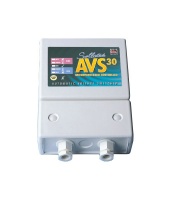Related Products
Product Description
Sollatek AVS3P-0 Automatic Voltage Switcher for 3-Phase loads Product Description
AVS3P 0
Sollatek AVS3P 0 Automatic Voltage Switcher for 3 Phase loads
Description
The AVS3P 0 is an Automatic Voltage Switcher designed to protect 3 phase loads from voltage fluctuations, over voltage, under voltage, surges, dips and frequent start/stops. The output is a single volt free changeover contact, rated at 16A. This is intended to control an external contactor, control circuit, start/stop system or alarm. If the voltage on any 1 phase goes above or below the pre set limits the window , then the AVS will switch off. Once the voltage returns within the window limits, the
AVS will wait for a pre set time, continuing to check the voltages, before automatically turning the load back on. The over voltage, under voltage and delay settings are all adjustable using controls in the terminal compartment of the AVS3P. The standard window that is considered acceptable is 185V 260V 320V 450V 3 phase . Outside these limits electronic and electrical equipment are likely to be damaged.
1. Connect the AVS in accordance with the wiring diagram opposite fig 1 . Ensure that the R , S
T sensing connections to the AVS come from the supply side of the contactor. N ote a good
neutral connection must be provided from the supply.
2. The output from the AVS is a changeover relay with volt free contacts. There is a common C ,
a normally open NO and normally closed NC contacts. W hen the AVS3P 0 is in the R ed or
Amber condition then C is connected to NC . W hen the AVS3P 0 displays G reen then C is
connected to NO . M ake sure that the control current you wish to switch does not exceed the
rating of the AVS3P 0 relay max 16Amps .
3. If the AVS is the only thing to control the contactor or load, or alarm, etc , then the C and NO
AVS contacts can be used to connect power to the contactor coil method A . I f however, there
are other circuits/equipment that also must control the contactor, then the AVS contacts can be
used to interrupt the contactor coil supply from there method B or used in conjunction with a
start/stop or other system, e.g. method C .



